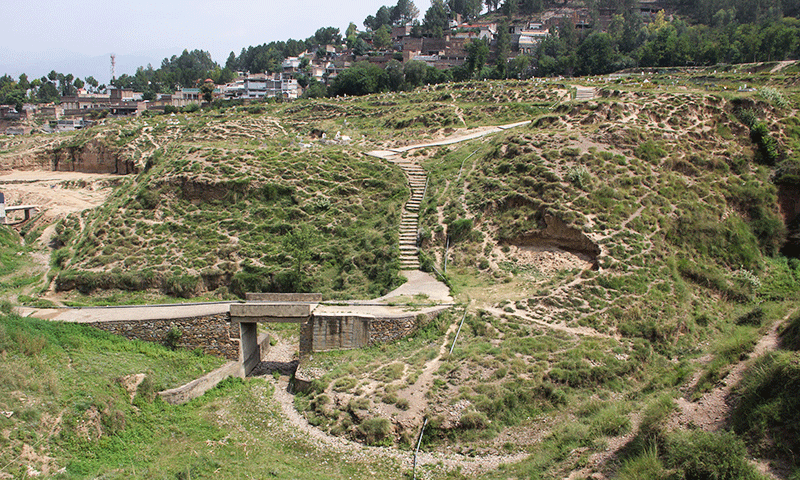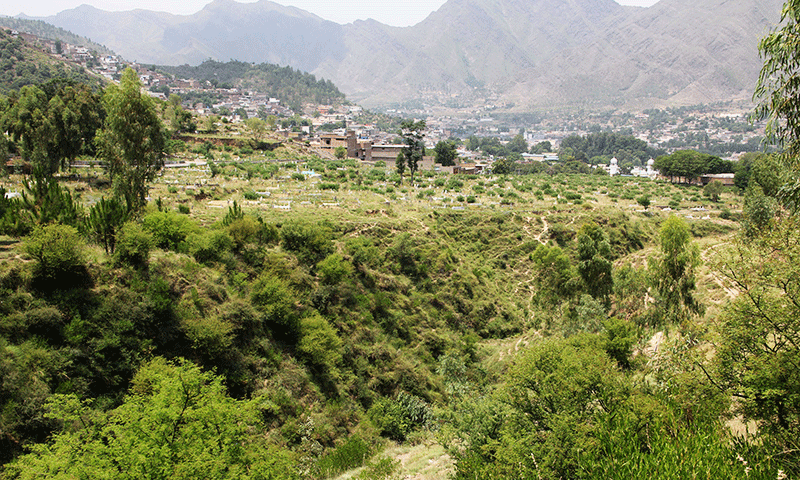 |
| A view of the mud canyon at Saidu Sharif in Swat. — Photo by author |
MINGORA: That the idyllic Swat valley was once the hotbed of Taliban extremists is hardly unknown, but what is less known is the sordid way in which death row inmates in the erstwhile princely state met their end.
Only 23 murders occurred during the two-decade rule of Wali-i-Swat Miangul Abdul Haq Jahanzeb, the last ruler of the princely state before it acceded to the federation. Between 1949 until 1969, each perpetrator was arrested and punished — a testament to the government's strong writ in the area.
Murderers were awarded the maximum punishment of a death sentence. But unlike the conventional 'death by hanging' method exercised in prisons today, convicts in Jahanzeb's reign were executed in public.
 |
| A view of the mud canyon at Saidu Sharif in Swat. — Photo by author |
On the day of execution, the death row inmate was taken to a deep mud canyon where he would be shot twice in the chest with a rifle while people from across the valley would flock to see the execution to satiate a morbid fascination.
Swat became a part of Pakistan in 1969, before which it was an autonomous princely state with its own system of dispensing justice — including executing prisoners on mud canyons.
Ismail Khan, a resident of Saidu Sharif, vividly recalls the time.
"After receiving word of the execution, we would rush to the edge of the gorge to witness it,” he says. The news would spread like wildfire to far-flung areas, particularly with children whispering among their friends, he adds.
Arena of fear
Locals who remember the time say death row convicts would cry loudly minutes before the execution, their shrieks becoming an ominous warning for villagers in the area.
 |
| An inside view of Swat prison. — Photo by author |
There are also some who remember the execution arena as a place that left people feeling immensely fearful, and one that resulted in lasting nightmares for those who ended up watching the practice.
Itbar Gul, another resident of Saidu Sharif, describes the place of execution as frightening and grisly.
“I was terrified of going there but my friend took me forcefully. After witnessing a live execution, I had ghastly nightmares for a long time,” he says.
How executions came to Saidu Sharif
The mud canyon was originally located in Mingora’s Faizabad area and it was much later, after a prison was constructed in Saidu Sharif, that the city began to witness executions.
Haji Rasool Khan, an elderly man from Mingora who had also worked in Swat’s administrative machinery, says the first mud canyon of the region was located in Faizabad.
 |
| A bridge connecting both sides of the graveyard along the canyon. — Photo by author |
"Death row convicts from all parts of Swat were executed in Faizabad because the first prison of Swat was close to the canyon over there," he says.
Later, in 1957, a prison was constructed in Saidu Sharif and consequently executions were also shifted to the canyon which was closer to the jail in that city.
At present, the largest graveyard of Swat, Saidu Sharif, surrounds both sides of the mud canyon, with houses built on the lower side.
The policeman condemned to death
A local Shamsul Iqbal Shams recalls the story of a policeman who was sentenced to be executed following the death of a beggar in the late 60s.
 |
| A view of Swat's largest graveyard. — Photo by author |
The beggar would routinely queue up outside the tomb of prominent religious leader Akhund Abdul Ghaffur alias Saidu Baba in the hope of getting alms from tourists and pilgrims.
"The state police would have to intervene to prevent the beggars from becoming a hurdle in the way of visitors. They would also be on guard for the security of pilgrims and visitors,” he recalls.
"One day a policeman pushed away a beggar who was pestering visitors for money. Unfortunately, the beggar was struck hard and died. When the case went to Wali sahib (Miangul Abdul Haq Jahanzeb), he condemned the policeman to death."
Although he was just six years of age that July, Shams said he followed the condemned policeman to the location of the execution.
"The day the convict was executed, my friends and I reached the canyon, sat on the edge and watched it unfold before us. The sentenced man was tied to a tree and then policemen shot him twice."
 |
| A view of the upper side of Swat valley and Saidu Sharif town. — Photo by author |













































